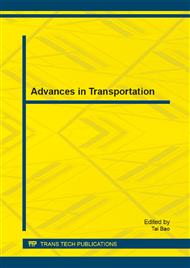p.813
p.820
p.827
p.832
p.840
p.845
p.849
p.853
p.858
Transit Network Design Model Based on Transport Efficiency
Abstract:
Transit network design is an important part of urban transportation planning. The purpose of this paper is to design transit network considering transport capacity constraint. The aim of the proposed method is to maximize transport efficiency of network. Transport efficiency and routes impedance are defined based on the road restriction coefficient matrix. The k-shortest paths algorithm is applied to search efficiency route and the highest efficiency route is selected to be laid on the road network. Then, station OD matrix is updated considering station capacity. The model is illustrated with data from Siping city, China and results show that the transport efficiency of transit network is highest and meet the correlative design norms. Therefore, the model got a higher practical value.
Info:
Periodical:
Pages:
840-844
Citation:
Online since:
January 2014
Authors:
Price:
Сopyright:
© 2014 Trans Tech Publications Ltd. All Rights Reserved
Share:
Citation:


